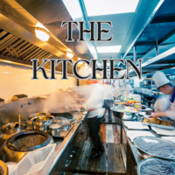
Overview
Synopsis
Arnold Wesker’s groundbreaking play is set in the basement kitchen of the Tivoli, a large and busy London restaurant with a high, frantic turnover of both customers and staff. An international melange of chefs, waitresses and porters set up for the day as they prepare to serve lunch. The pace builds and tempers flare as the cooks butt heads, the waitresses chase their orders, and the beers are downed to get through the day. In the midst of the chaos, Peter, a high-spirited, young German chef carries out a doomed, tumultuous love affair with married English waitress, Monique. When he finally realizes that she will never leave her husband, something in Peter snaps and he destroys the gas leads to the kitchen ovens. Hurt and bewildered by his employee’s actions, restaurant owner Mr Marango is left to wonder what more his workers need in their lives other than employment, money, and food.
The Kitchen was the first British play to dramatize the relentless rhythm and toil of the working day and portray a kind of mechanized hell in which hundreds of meals must be served in a short space of time.
Show Information
Context
Plot
Characters
| Name | Part Size | Gender | Vocal Part |
|---|---|---|---|
|
Lead |
Male |
Non-singer |
|
|
Supporting |
Male |
Non-singer |
|
|
Supporting |
Female |
Non-singer |
|
|
Supporting |
Male |
Non-singer |
|
|
Supporting |
Male |
Non-singer |
|
|
Supporting |
Male |
Non-singer |
|
|
Supporting |
Male |
Non-singer |
|
|
Supporting |
Male |
Non-singer |
|
|
Supporting |
Male |
Non-singer |
|
|
Supporting |
Male |
Non-singer |
|
|
Supporting |
Male |
Non-singer |
|
|
Supporting |
Male |
Non-singer |
|
|
Supporting |
Male |
Non-singer |
|
|
Supporting |
Male |
Non-singer |
|
|
Supporting |
Female |
Non-singer |
|
|
Supporting |
Male |
Non-singer |
|
|
Featured |
Male |
Non-singer |
|
|
Featured |
Male |
Non-singer |
|
|
Featured |
Female |
Non-singer |
|
|
Featured |
Female |
Non-singer |
|
|
Featured |
Male |
Non-singer |
|
|
Featured |
Male |
Non-singer |
Songs
A song with an asterisk (*) before the title indicates a dance number; a character listed in a song with an asterisk (*) by the character's name indicates that the character exclusively serves as a dancer in this song, which is sung by other characters.
Monologues
Scenes
Key Terms
An economic system often critiqued in epic and protest theatre, examining exploitation, class, and power structures.
A British theatrical movement from the 1950s–60s that depicted working-class life with gritty realism and domestic conflict.
A theatrical movement that strives to depict everyday life and authentic behavior on stage. It often focuses on domestic settings and psychological depth.
Videos
Quizzes
Themes, Symbols & Motifs
Sorry! We do not currently have learning modules for this guide.
Quote Analysis
Sorry! We do not currently have learning modules for this guide.
